As a customer, frustration arises when there’s a prospect of standing in a serpentine queue to purchase movie tickets. Not only limited to theatres, queues present problems at numerous places of work such as hospitals, banks, government establishments, airports, and so on.
Such situations gave rise to the necessity for devices that operated without human intervention and facilitated quick interaction and completion of processes. Thus, arose the digital, interactive kiosk.
Digital Kiosks are omnipresent and indispensable today, proving their worth at multiple institutes. These kiosks run on specially designed kiosk software solutions, which ensures minimal human involvement in daily operations. This helps professionals turn their attention to highly specialized and demanding tasks or processes.
Defining a Kiosk
Kiosks have a variety of definitions based on different cultures. However, this blog will focus only on the interactive kiosk.
An interactive kiosk is defined as a computer device or terminal, which delivers value to customers through the delivery of information and communication, the completion of important transactions, and access to multiple applications for task completion.
They are standalone devices, usually comprising specialized hardware and software. They are generally set-up for use in both public (E.g., retail stores) and private spaces (E.g., corporate offices).
Different types of Kiosks

Kiosks are classified on the functionalities they perform. Different types of Kiosks that exist today include the following –
1. Self- Service Kiosks – These kiosks put the user in charge of the task they want to perform and facilitate quicker and simpler task completion. Some notable examples of self-service kiosks are mentioned below:
A. Financial service kiosks – E.g., ATMs
B. Ticketing service Kiosks - E.g., Movie Ticket Kiosk
C. User Authentication Kiosks - E.g., Visitor Management Systems
D. Retail Kiosks
E. Restaurant Kiosks
2. Vending Kiosks – These kiosks generally dispense certain goods for user consumption or necessity.
3. Map and Building Directory Kiosks – Stationed at the entrances of malls and shopping plazas, these kiosks contain a map of the entire complex. Added information in terms of location of stores, names of brands with outlets on the premises, etc., are also present to facilitate user movements.
4. Photo Kiosks – These kiosks are present in public spaces, generally malls. Users enter the kiosk and have their pictures taken after giving input to the program. Some of these kiosks are also automated to measure user movements and time for a picture.
5. Advertising Kiosks – These kiosks are generally termed digital signage kiosks. They are programmed to run multiple advertisements and announcements through multiple media formats - be it music, or motion pictures, or even documents.
6. Internet Kiosks – Present in public centers, such as libraries or even transport hubs, internet kiosks are computer terminals with a connection to the web and an in-built browser. User functionality is limited to just surfing the web.
7. Information Kiosks – These kiosks are digital repositories of information on a variety of topics, which are searched for by the user. The kiosk is installed in public places.
Importance of using a Kiosk Software
- Protecting business and customer data
- Functionality at a user’s fingertips
- Marketing purposes
- Data Analytics needs
- Administrator access Management
- Automating key remote processes
- Content Regulation
- Third-party tool integration on terminal
Who uses Kiosk Software?
Widespread and important in a dynamic environment, kiosks can carry out a litany of functionalities. Some of the most important sectors of kiosk usage areas listed –
- Higher Education – Kiosks are present in libraries of schools and colleges, where students can access and read materials and subjects aligned with their interests. Kiosks are also used for visitor entry and registration.
- Government establishments – Kiosks at government institutions are used as visitor management systems, ATMs, maps and building directories, and ticket dispensing.
- Healthcare– Kiosks at hospitals are vital inpatient registry and management, digital signage, Medical Record updates, etc.
- Transportation – Airports, and railway stations have implemented kiosk systems for ticket generation and scanning, alongside specific vending kiosks for goods before travel.
- Entertainment and Recreation – Movie theatres and parks have implemented interactive kiosks for ticket booking and scanning purposes. The kiosks detail the activities conducted/ movies playing, allowing the user to choose an option.
- Hospitality – Kiosks are placed outside dining houses to allow users to make reservations or order food before being seated for quick service. Kiosks are also used for user registrations and record-keeping for loyalty programs at dining houses.
- Attractions - Information kiosks have been installed in close proximity of attraction centers. These centers range from historical and heritage structures to zoos and man-made wonders. Ticket dispensing kiosks have also been initiated to allow tourists to easily attain tickets or use certain facilities, like the canteen.
- Worship - Kiosks have been installed and operated outside famous centers of worship around the world. They range from information kiosks to ticket dispensing kiosks.
- Food and Beverage - Vending machines reside in facilities all over the world, whether transportation hubs or offices. These kiosks dispense with food and drink, corresponding to a certain product ID and the requisite amount of money.
- Retail - Retail kiosks have been implemented in certain clothing chains around the world. These kiosks offer visitors a chance to order products online, even facilitating payments on them. They are mostly informational - carrying a complete catalog of the brand’s products.
- Trade shows - Events such as a car trade show will have information kiosks set up beside models or passers-by to read up on the vehicle or displayed product. These kiosks may also contain other functional abilities, such as pre-booking demos.
Features of Kiosk Software
- Secured Browsing– Kiosk software ensures vital functionalities of the system cannot be accessed without permission, making the underlying OS tamperproof.
- User Management – Kiosk software usually segregates administrators and general users. Users will be allowed only specific functionalities for security purposes, while administrators oversee the running of all kiosks.
- Analytics and reporting – Interactive kiosks can be used to delve in usage metrics to tweak performance and offer more functionalities to users.
- Exceptional User Interface – Kiosks are renowned for their fluent and simple to navigate interfaces. This helps
- External Device Integration – Kiosk software has inbuilt APIs and codes to allow for third-party hardware and software integration to increase functionalities of kiosks.
- Sessions Management – A session is recorded every time a user logs into the system to use the kiosk. Session logs are maintained, and users are automatically logged out of sessions once the period elapses. Session data is also deleted for privacy and GDPR reasons.
- Remote Monitoring and Updating – Kiosks can be set to automatically update software from remote servers without human intervention. Similarly, important information and logs can be accessed by administrators, using kiosk management tools, remotely.
- Alerts and Notifications – Users can be notified of time consumption, while administrators are alerted if users display irrational behavior on the terminal. Alerts also go to administrators when terminal kiosks are updated.
- Virtual keyboard – an important facet of every kiosk system is the presence of a virtual keyboard. It helps negate the necessity of having a hardware keyboard, and increased functionalities help abled as well as specially-abled users in data entry.
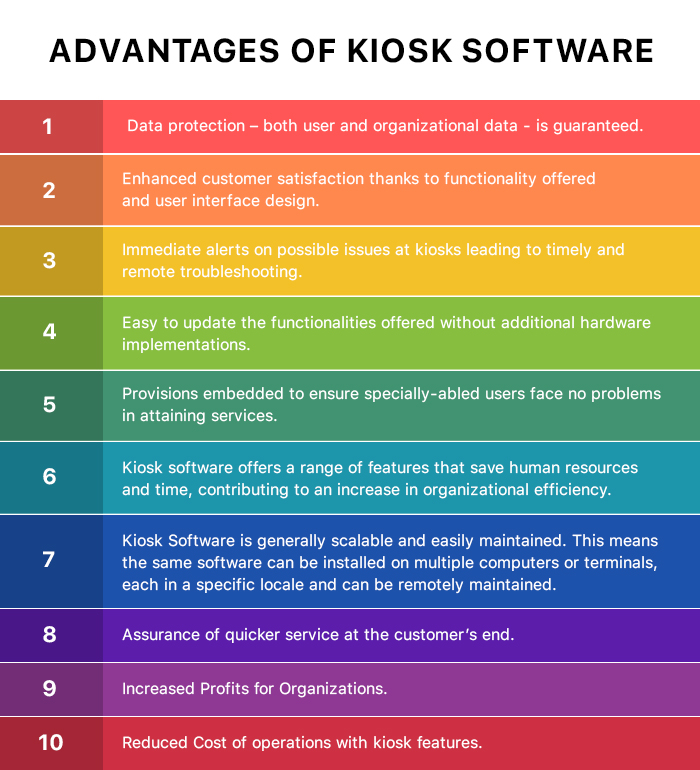
Kiosk Software - Then and Now
The first-ever kiosk system was invented by Lexitech solutions. IBM, with the help of Lexitech’s, founder Ale Richardson, set up prototype kiosks around college campuses to help guide IBM-specific seminar attendees across buildings and convention rooms to the correct center. The device was a large screen IBM device that offered little computer and hardly any interaction with the user.
It accessed important information for the user, and displayed it, laying the way for future self-service devices. This model was replicated across American hubs like New York, where a large console connected to a keyboard facilitated jobseekers in submitting applications to companies.
However, these were rudimentary devices with minimal functionality.

In the 1990s, KioskLogix brought Netstop to the market. It was the first commercial kiosk software that was easy to download and installed on a Windows system or terminal to convert into a restricted kiosk. The kiosk software was based on a pay-per-use model.
Kiosk software then had to be manually configured per system to allow additional data storage or hardware devices. Closed source software meant companies with patents generally extracted licensing fees from smaller players.
Modern Kiosk software is multi-functional. As listed below, there exists an array of free and open source kiosk software. Also, the kiosk system today is far more interactive as compared to previous kiosks.
Users can execute many functions over the web, while hardware devices and third-party applications in the system help accomplish work. Kiosk software devices which power touch screen devices are useful in accomplishing tasks faster.
Comparison Chart of the Top 7 Free and Open Source Kiosk Software

Porteus is a light, free and open source Kiosk software. It is Linux-based and has a standard version that only allows the usage of a web browser. Furthermore, strict protocols ensure the user isn’t able to install software or change the settings.
The software, however, is configured to run only on CPUs that operate on 64-bit instructions.
Predominantly used in schools and libraries, this kiosk software solution is also implemented in hotels, cafes, and offices. Porteus has four model upgrades, each built on the base system. They are the Porteus Kiosk Cloud, Porteus Kiosk ThinClient, and Porteus Kiosk Server. Each model offers a few functional differences over the kiosk software.

Source - Porteus
Features of Porteus Kiosk are as follows –
- Lightweight – The Porteus Kiosk software solution generally runs on low specifications. It requires minimal random access memory (RAM) and uses 100 MB of storage on initial download.
- Configuration – The Porteus Kiosk Software comes installed with a Kiosk Wizard, which allows users to install the software with the click of just one button. The wizard also permits the users to make select changes to the User Interface (UI) of the software by nothing more.
- Automatic Updates – Porteus Software runs on a rolling update model. Termed as a ‘Setup and forget’ model, the kiosk requires no human intervention while updates roll onto it.
- Data Privacy – The system ensures no user sessions are stored locally or remotely. All caches are also cleared once a user session ends. This ensures total protection of a user’s sensitive data, after browsing ends.
- Default Lockdown – The kiosk system only allows a kiosk owner (administration team) or a Porteus team to access and make changes internally. This rigorous security set-up allows Porteus to use public WiFi networks without fear of malicious user actions, external or internal.
2. WebConverger
This Kiosk Software solution is based on the latest stable Firefox releases as well as Debian stable updates. The software runs only on the x86 family of processors. Relatively lightweight, it requires 1 GB of RAM. It is supported on the Raspberry PI 2 or any device running Android OS version 5 or above.
A Singapore registered company by origin, Webconverger is an open source kiosk software, which has an initial free version, which is not configured to any PC specification. Subsequent versions require payment for deployment and have added features. There have been over 5000 deployments of the software.

Source - Webconverger
Some features of the Kiosk software are as follows –
- Data Privacy – The kiosk software solution aims to maintain user privacy by ensuring history sessions of users are not recorded. All caches are cleared once the browser is closed and no password data is saved.
- Default interface – The interface on the system is limited to just a default web browser/website or application. This prevents unnecessary modifications by a user not authorized to access other important functionalities.
- Scalability – The software is easily replicable across multiple terminals. Furthermore, one terminal can be used to modify the characteristics of the software on other terminals. E.g., changing wallpapers is easy thanks to a one-to-many mapping function - unique to the configuration tool - on this free kiosk software.
- Automatic Updates – The kiosk system does not have an End of Life (EOL). This means all security systems and configurations for browsers and applications are updated automatically, without human intervention, for the lifetime of the software on a terminal.
3. Libki
A free and open source kiosk software, Libki was authored by Kyle M Hall. The Kiosk software’s primary functions are that of a time and reservation management system, allowing users timed access to use a computer or terminal.
Libki is best implemented in a controlled computing environment such as public libraries and school laboratories.
The Libki Kiosk software solution ecosystem consists of two components – a cross-platform client and a web-based server. The client can run on multiple operating systems and is lightweight. Features of the client include a user-facing time counter and terminal access functions. The client can be programmed to log users off the computer and even restart computers themselves after intervals or remotely.
The web-based services can be accessed by a networked computer to carry out user management at individual Libki terminals (ban, log-off, message users, etc.). The server is also used for terminal management, besides remote reservations management of particular computers.
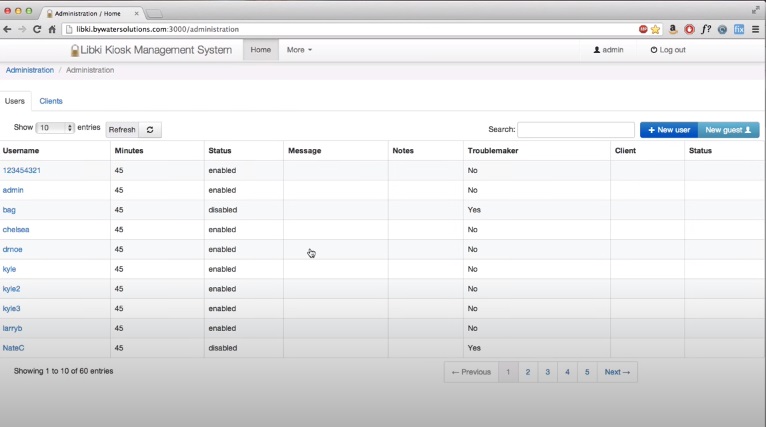
Source - YouTube
Some important features of Libki are as follows –
- Single Sign-on – Thanks to this feature, users need not remember a single username and associated password to avail kiosk functionality. Instead, multiple user accounts are created every time a user, new or old, logs in to a Libki kiosk.
- Google Cloud Print Integration – A real asset of the kiosk system is its print management. There’s no need for additional infrastructure when Libki is used with the GCP solution set.
- Operation hours – The Libki kiosk software can be pre-programmed to ensure it only operates between specified hours of access. The kiosk system will refuse to operate when tried to be accessed post these hours.
- Time Management – Libki can be configured to cap time allotted to a user, or leave it unlimited. The presence of user dedicated controls ensure that they can request additional time as well. The system is in-built with an alert system as well.
- Customization – Libki allows the customization of the login screen on the client terminal. Provisions are available for banner images, whose content is modified using the Libki server.
- Access Management – Guests accounts are generated, which do not have the same operational rights as registered accounts. Furthermore, the kiosk system can be altered to restrict users on various parameters, such as age and other parameters.
4. Linutop
Linutop is a kiosk software that can be installed on any computer terminal or device. The software guarantees secure internet access, provides the ability for digital signage, and allows integration of multimedia onto the default browser page. The multimedia can be added using a local player or via linutop.tv.
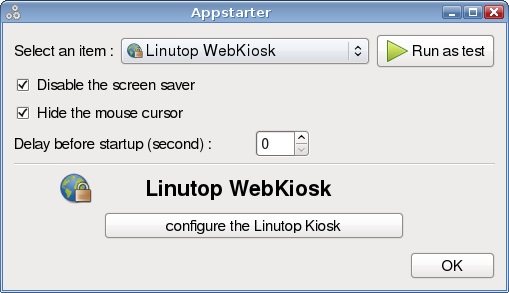
Source - Linutop
The kiosk software’s features are as follows –
- Digital Signage and Narrowcasting – The free kiosk software can be used to display photos, videos, or even play specific kinds of music. This feature is used to display digital content such as advertisements or public announcements.
- Narrowcasting can be controlled remotely via Linutop.tv, while predefined content can be loaded onto the lightweight kiosk software.
- Linutop Remote – Instead of loading messages all at once into the kiosk system, Linutop’s remote application allows you to control the digital content on the screen through a mobile web browser. Through this, channels and playlists may be adjusted to display on the terminal/ computer
- Lightweight OS – The Linutop kiosk software is very lightweight and can be uploaded on a device as miniature as the Raspberry Pi.
- Multi-platform compatibility – The kiosk software solution is operable on both Windows and raspberry Pi without major changes or upgrades needed.
5. NetKiosk
Netkiosk, specialists in kiosk software, have released a chromium powered tool named Imperi. The 2020 version of the kiosk system is a chromium powered browser that facilitates the kiosk mode. Imperi ensures a user will not be able to use functionalities such as a taskbar or even keyboard shortcuts, once implemented on a system. Furthermore, the free kiosk software will only run on Windows supported devices. Versions supported are – Windows XP (SP3), Windows 7, 8 and, 10, and Windows NT.
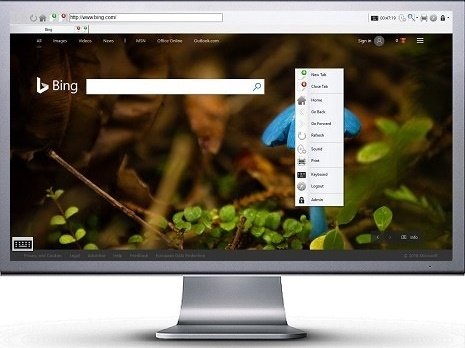
Source - NetKiosk
Some other features of Imperi are as follows –
- Administrator Access Control – The free kiosk software consists of an administration panel that can control all aspects of the terminal. The administrator oversees user access tools - such as which websites they can browse – and decides the layout of the kiosk system.
- Multi-mode – The kiosk software has two modes of operation. A browser mode enables users of the terminal to open and close browser tabs, as per their usage, bar the first. Display mode doesn’t allow any browser menu option. Similarly, adjustments can be made to ensure either Netkiosk’s proprietary keyboard or a standard Windows touch keyboard be used.
- Light-weight - This kiosk system takes less than 95 MB of storage capacity to download.
- Open Source – Netkiosk is part of the Chromium open source project, powered by Google. This ensures stability and security in surfing the web.
- Scalability – Imperi kiosk software does not have a limit on the number of terminals that it can be installed on.
6. Zamok
Zamok kiosk software solution suite offers a plethora of functionalities that enable kiosks to do much more. Built over the Windows operating system on the company’s terminals, this kiosk system provides benefits such as security and third-party tool integration besides many others.
Zamok can also be installed on third-party terminals without much addendum.

Source - AdvancedKiosk/Zamok
The features of this kiosk management software are as follows –
- Document scanning – The kiosk system allows documents to be scanned, prompting users on the steps - through a beautiful interface – before confirming the previews areas required.
- Handicap assistance – The implementation of easy access tools enables the kiosk software to be of service to specially-abled people.
- Administration – The kiosk software restricts access to important operating system functionalities to the administrator, who can view the status of all Zamok operating terminals. They can also update system software when necessary.
- Hardware integrations – The kiosk system supports a variety of hardware such as printers, biometric scanners, touchpads, and even physical keyboards.
- Security and content – A lock of browsing capabilities, limiting the view to specific content per kiosk, can be achieved. Unwelcome tampering, unauthorized access, and unregulated surfing can be eliminated.
- Layout control – The kiosk can be made to represent a digital signage, with messages, pictures and videos all taking over the screen. Users of Zamok can also customize the screen to display specific content.
7. Intuiface
Intuiface is a software tool that is used to convert text and multimedia content - such as videos and pictures - into much more interactive solutions. These solutions are then implementable across a wide variety of hardware tools such as kiosks, where digital signage and other interactive components are deemed necessary.
Intuiface consists of a composer, where user-created or standard multimedia are dragged and dropped. Using tools present within the interface, users can customize the content to make it more interactive, highly engaging, and personalized.
The kiosk software solution also consists of an ‘Intuiface player’, which can be loaded onto a touch screen terminal or device. The content created using the composer is deployed on the player. An Intuiface Analytics engine then hones in insights from usage.
Some of Intuit’s biggest customers include ANWB and the Royal Mint. Intuiface follows a versioning pricing - pattern. The free version is available for an easy download, whereas Essential, Premier, and Enterprise versions are priced on a yearly - from Euro 600 to Euro 1899 per year.
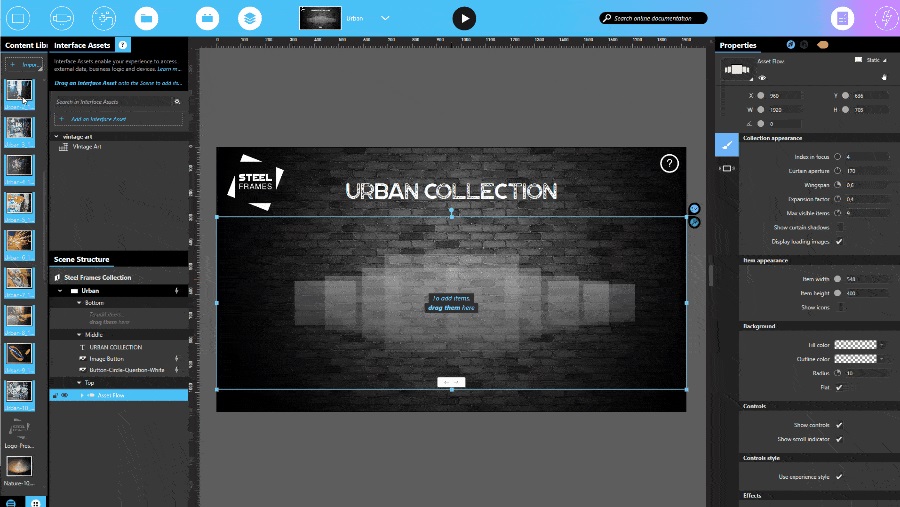
Source - Intuiface
The biggest features of the software are as follows -
- Analytics engine - Used for honing business insights, trends, and ideas from user behavior on the terminals or devices.
- Platform Independent - The kiosk system can operate on six of the most widely used operating systems.
- Easy to implement - Intuiface involves NO CODING to convert media to interactive components for deployment. All components can be created using pre-built system definitions within Intuiface’s library.
- Hardware independence - Lightweight and easy to configure, Intuiface’s solutions can be implemented across hardware devices of different specifications, and screen sizes.
- Personalization - The kiosk software solution can extend its functioning to involve dynamic data sources and other components of the IoT. Multiple tools also exist on the interface to link user data to back-office systems.
- Virtual keyboard - Intuiface’s virtual keyboard comes pre-programmed with support in 30 different languages, with tools to also assist specially-abled people in kiosk usage.
- Third-party application integration - Intuiface’s Web Triggers API allows cloud-based apps and data sources to communicate with Intuiface devices. Hardware readers such as RFID and NFC support can also be updated into a kiosk solution.
- Remote Kiosk Management - The presence of a remote API allows Intuiface interfaces across devices on the same intranet or internet to be controlled by third party applications. Not only this, Intuipad integration also enables iOS and Android to be controlled by a single server without having to sacrifice the human interaction on the kiosks.
All the free and open source kiosk software listed above will help you implement your kiosk smoothly. There exists, however, an influential software that can help you achieve much more in your quest to set-up the perfect kiosk. The following section will discuss KioWare software, one of the most popular Kiosk Software solutions.
KioWare
KioWare Kiosk Management is one of the most popular kiosk software tools. The kiosk software solution comprises two components – a client-side tool and a browser-based server.
The client is installed on a terminal, tablet or PC, restricting access to browsing capabilities and securing the environment. KioWare’s robust management tools also dictate the functioning capabilities and user experiences of KioWare clients.
The KioWare server is installed on another device that’s on the same network configuration as that of the client, in tandem with a MySQL database or SQL server.
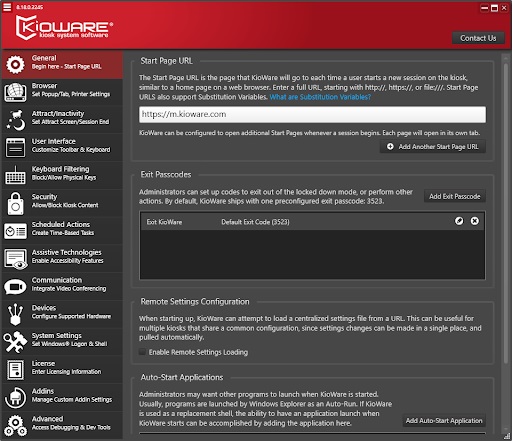
Source - KioWare
Some of the features of KioWare are as follows –
- Content-control – KioWare’s server can monitor, evaluate and manage locally stored content through remote functionality. The server executes revision control, which enables constant contact between kiosks and servers, enabling automatic downloads.
- Data Storage – Available locally on each kiosk, ad-hoc data structures prevalent help in storing relevant information regarding every kiosk. E.g., location, hardware, etc.
- Third-party applications – KioWare’s API enables developers to innovate and produce software compatible with KioWare Severs. If need be, the kiosk software solution will be implemented across kiosks, furthering application capability.
- Automation – KioWare can be used to instantaneously download files from a centralized location, on every startup. The kiosk software then unpacks the files, installs data updates and reconfigures the system as necessary.
- Citrix Terminal support – KioWare kiosk software allows individual terminals to run different versions and configurations of KioWare. If half the application terminals operate on a visitor management configuration, the other half will run HR operation functions. The software also allows functionality in a Citrix/Terminal configuration.
- Flexible Users – The accessibility to certain functions can be altered per user. The permissions and roles can be controlled by the administrator.
Conclusion
Despite a surge in mobile computing capabilities, Kiosk software remains incredibly popular. Our list of free and open source kiosk software aims to decrease the perseverance involved in choosing the best fit for your computing and business capabilities.
Have you ever used some of the top kiosk software mentioned on GoodFirms? Don’t feel shy to share your feedback with us.
Please use the comments section to share feedback and opinions about the article as well.
Still feel short of options? Peruse through GoodFirms’ exceptional list of kiosk software. Kiosk Software solutions such as SiteKiosk and, Scalefusion make a compelling argument in their favour as well.
Kiosk software and Kiosk systems still not your primary goal? Check out GoodFirms’ vast Software Directory to help you identify the right fit for your business necessities.
